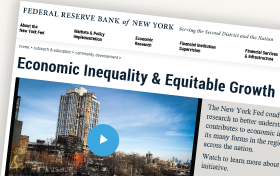February 22, 2023
The following frequently asked questions (FAQs) provide further information about the Federal Reserve's secondary market transactions in Treasury securities.
Why does the Desk conduct small value outright operations in Treasury securities?
The New York Fed undertakes certain small value open market transactions for the purpose of testing operational readiness to implement existing and potential policy directives from the Federal Open Market Committee (FOMC).
Do small value operations reflect a change in the FOMC’s directive or signal a shift in policy?
No. Small value operations are conducted for the purpose of maintaining operational readiness, rather than to fulfill a policy directive, and therefore do not indicate anything about the future timing or direction of changes in policy. The Desk executes these operations pursuant to the FOMC’s Authorization and its Continuing Directive for Domestic Open Market Operations.
How will the Desk communicate its small value operations plans?
The Desk plans to conduct small value outright operations approximately every other month and in amounts of up to $150 million in a given month. The Desk will communicate its planned monthly transaction amount and release its tentative schedule of operations on or around the ninth business day of each month in which it plans to operate. These announcements can be found on the Treasury Securities Operational Details page. The tentative schedule will include information on the upcoming operation dates, times, security types and maturities, and maximum transaction amounts.
In what Treasury securities does the Desk operate?
Treasury small value operations may be conducted across a range of maturities and security types. They may include nominal coupon securities, bills, Treasury Inflation-Protected Securities (TIPS), and Floating Rate Notes (FRNs).
The Desk’s tentative schedule will communicate the operation type, security type and maturity range of each operation in advance. The Desk will refrain from conducting purchase operations in securities that are trading with heightened scarcity value in the repo market for specific collateral, newly issued nominal coupon securities, and securities that are cheapest to deliver into active Treasury futures contracts.
Additionally, the Desk will not operate in securities with four weeks or less to maturity and TIPS with one year or less to maturity. Specific issues that will be excluded from consideration will be announced at the start of each operation. Currently, the Desk does not plan to transact in STRIPS, securities trading in the when-issued market, or cash management bills.
What are the limits on System Open Market Account (SOMA) holdings of any one Treasury issue?
The Desk limits SOMA holdings to a maximum of 70 percent of the total outstanding amount of any individual Treasury security.
What are the limits on SOMA purchases of any one Treasury issue?
The Desk allows the share of SOMA holdings of an individual Treasury security to rise above certain levels only in modest increments.
For nominal coupons, TIPS, and FRNs, the Desk allows the share of SOMA holdings of an individual Treasury security to rise above 35 percent in increments, as shown below.
| Purchase Limits for Nominal Coupons, TIPS, and FRNs | ||
SOMA Security Ownership Prior to Operation as a Percentage of Outstanding |
Maximum Purchase Amount per Security in Operation is the Lesser of (A) or (B): | |
| (A) | (B) | |
| 0-30% | N/A | (35% of Outstanding) minus SOMA Holdings |
| 30%-47.5% | 5% of Outstanding | (50% of Outstanding) minus SOMA Holdings |
| 47.5%-59% | 2.5% of Outstanding | (60% of Outstanding) minus SOMA Holdings |
| 59%-70% | 1% of Outstanding | (70% of Outstanding) minus SOMA Holdings |
| Above 70% | Not Eligible for Purchase | |
For bills, the Desk allows the share of SOMA holdings of an individual Treasury security to rise above 17.5 percent in increments, as shown below.
| Purchase Limits for Bills | ||
SOMA Security Ownership Prior to Operation as a Percentage of Outstanding |
Maximum Purchase Amount per Security in Operation is the Lesser of (A) or (B): | |
| (A) | (B) | |
| 0-15% | N/A | (17.5% of Outstanding) minus SOMA Holdings |
| 15%-34% | 2.5% of Outstanding | (35% of Outstanding) minus SOMA Holdings |
| 34%-59.5% | 1% of Outstanding | (60% of Outstanding) minus SOMA Holdings |
| 59.5%-70% | 0.5% of Outstanding | (70% of Outstanding) minus SOMA Holdings |
| Above 70% | Not Eligible for Purchase | |
Does the Federal Reserve lend the Treasury securities it owns?
Yes, Treasury securities held in the SOMA are available to borrow through the SOMA’s securities lending facility. For more information on Securities Lending, please see here.
How are SOMA holdings of Treasury securities reported?
SOMA Treasury holdings are reported on a weekly basis in the H.4.1 statistical release. Over any period, changes in the H.4.1 line item "U.S. Treasury securities" reflect the net effect of rollovers, purchases, and sales of Treasury securities, as well as movements in inflation compensation. For a full list of SOMA holdings, please see here.
Who is eligible to transact in Treasury outright operations with the Federal Reserve?
The Federal Reserve Bank of New York's primary dealers are eligible to transact in Treasury purchase operations directly with the Federal Reserve. Dealers are expected to submit bids and offers for both themselves and their customers.
How are outright operations conducted?
The Desk conducts Treasury outright operations via FedTrade, the Desk’s proprietary trading system. FedTrade operations are generally conducted using multiple-price, competitive auctions with approved counterparties. A "multiple-price" auction is an auction in which securities are awarded at the price corresponding to the participant’s bid or offer in the operation, resulting in the security being awarded at multiple prices. The minimum auction amount, bid/offer size, and bid/offer increment are each $1 million. Participants can submit up to nine bids or offers per security, with each bid or offer reflecting both a price and par amount. For Treasury bills, bids and offers will be entered as rates, whereas for FRNs, bids and offers will be entered as discount margin.
Propositions in FedTrade operations are evaluated based on their proximity to prevailing market prices at the close of the auction, as well as measures of relative value. Relative value measures are calculated using the Federal Reserve Bank of New York’s proprietary model.
How will the Desk communicate the operation results?
Operation results will be posted on the Federal Reserve Bank of New York’s website following each operation. The information posted will include the total amount of propositions received, the total amount of propositions accepted, and the amount purchased or sold per issue. In addition, participating dealers will receive the operation results, including their accepted propositions, via FedTrade, immediately following the close of the auction.
Will the Desk release operation pricing results?
The Desk will publish information on transaction prices in individual operations at mid-month for the prior monthly transaction period following periods in which the Desk conducts outright operations. For each security purchased or sold in each operation, the Desk will release the weighted-average accepted price/rate, the least favorable accepted price/rate, and the proportion accepted of each proposition submitted at the least favorable accepted price/rate.
In addition to the pricing information released each month, Section 1103 of the Dodd-Frank Wall Street Reform and Consumer Protection Act of 2010 requires that detailed operational results, including counterparty names, be released two years after each quarterly transaction period.
Whom should dealers call if they experience difficulties during the operation?
Primary dealers may call the Federal Reserve Bank of New York Trading Desk with submission and verification questions. For system-related problems, dealers may call the Federal Reserve Bank of New York Primary Dealer Support.
When and how does Treasury security settlement take place?
Treasury security settlement typically occurs on a T+1 basis, i.e. one business day after the day of the operation, via the Fedwire Securities System.
Does the Federal Reserve assess the TMPG Treasury fails charge?
Yes. The failure of the Federal Reserve's counterparties to deliver Treasury securities for the contractual settlement date of the Desk's trades has resulted in the Federal Reserve assessing the applicable Treasury fails charge recommended by the Treasury Market Practices Group (TMPG). Additional information can be found here.












